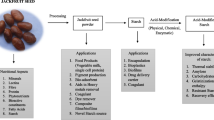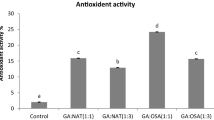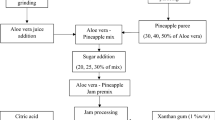Abstract
Whole jamun based functional confection (WJFC) was developed from an optimized blend (through response surface methodology) containing 26.585 % paste of jamun pulp with adhering skin, 2 % jamun seed powder, hydrocolloid mixture (2.289 % agar, 1.890 % pectin and 27.236 % polydextrose), antimicrobials (0.022 % benzoic acid and 0.085 % sorbic acid), and 40 % added water. The confection also contained 0.08 % sucralose, 0.06 % citric acid and 100 mg CaCl2.2H2O/g pectin. The confection was found to be rich in minerals like Ca, Mg, K, Na and P, with prebiotic activity and low glycemic index (48.1). Additionally, WJFC had reduced calorie (1.48 kcal/g) and high dietary fiber content (15.49 ± 0.058 g/100 g (db)). The antioxidant potential measured as DPPH radical scavenging activity and FRAP with different extraction solvents was found to range between 0.26 ± 0.01 and 0.98 ± 0.04 mg BHA/g and 2.57 ± 0.97 and 18.17 ± 1.30 μM Fe2+/g, respectively, with highest yield obtained for 50 % aq. ethanolic extract. Moreover, the antioxidant potential was observed to be dose dependent with IC50 values as 9.89 and 2.75 mg (db) against DPPH and superoxide anion radicals, respectively. WJFC was found to suppress α-amylase activity and retard glucose dialysis depicting the antidiabetic effect.


Similar content being viewed by others
References
Ahmed F, Urooj A (2010) In vitro studies on the hypoglycemic potential of Ficus racemosa stem bark. J Sci Food Agric 90(3):397–401
Ali RB, Atangwho IJ, Kuar N, Ahmad M, Mahmud R, Asmawi MZ (2013) In vitro and in vivo effects of standardized extract and fractions of Phaleria macrocarpa fruits pericarp on lead carbohydrate digesting enzymes. BMC Complemen Altern Med 13(1):39
AOAC (2012) Official methods of analysis, 19th edn. AOAC, Washington
Atala E, Vásquez L, Speisky H, Lissi E, Lopez-Alarcon C (2009) Ascorbic acid contribution to ORAC values in berry extracts: anevaluation by the ORAC-pyrogallol red methodology. Food Chem 113:331–335
Augustin LSA, Dal Maso L, La Vecchia C, et al. (2001) Dietary glycemic index and glycemic load, and breast cancer risk: a case-control study. Ann Oncol 12(11):1533–1538
Bali S (2007) A process for the manufacture of herbal candy. Patent No. 210880, India
Benherlal PS, Arumughan C (2007) Chemical composition and in vitro antioxidant studies on Syzygium cumini fruit. J Sci Food Agric 87(14):2560–2569
Benzie IF, Strain JJ (1999) Ferric reducing/antioxidant power assay: direct measure of total antioxidant activity of biological fluids and modified version for simultaneous measurement of total antioxidant power and ascorbic acid concentration. Methods Enzymol 299:15–27
Björck I, Liljeberg H, Östman E (2000) Low glycaemic-index foods. Brit J Nutr 83(S1):S149–S155
Cappa C, Lavelli V, Mariotti M (2015) Fruit candies enriched with grape skin powders: physicochemical properties. LWT Food Sci Technol 62(1):569–575
Chau CF, Huang YL, Lee MH (2003) In vitro hypoglycemic effects of different insoluble fiber-rich fractions prepared from the peel of Citrus sinensis L. cv. Liucheng. J Agric Food Chem 51(22):6623–6626
Chavan UD, Shahidi F, Naczk M (2001) Extraction of condensed tannins from beach pea (Lathyrus maritimus L.) as affected by different solvents. Food Chem 75(4):509–512
Chethan S, Sreerama YN, Malleshi NG (2008) Mode of inhibition of finger millet malt amylases by the millet phenolics. Food Chem 111(1):187–191
Chowdhury P, Ray RC (2007) Fermentation of jamun (Syzygium cumini L.) fruits to form red wine. ASEAN Food J 14(1):15–23
Chung HJ, Lim HS, Lim ST (2006) Effect of partial gelatinization and retrogradation on the enzymatic digestion of waxy rice starch. J Cereal Sci 43(3):353–359
Clifford MN (2000) Anthocyanins: nature, occurrence and dietary burden. J Sci Food Agric 80(7):1063–1072
Dar BN, Ahsan H, Wani SM, Dalal MR (2011) Effect of CaCl2, citric acid and storage period on physico-chemical characteristics of cherry candy. J Food Sci Eng 1(2):79–85
Das S, Sarma G (2009) Study of the hepatoprotective activity of the ethanolic extract of the pulp of Eugenia jambolana (jamun) in albino rats. J Clin Diag Res 3(2):1466–1474
Fisher EL, Ahn-Jarvis J, Gu J, Weghorst CM, Vodovotz Y (2014) Assessment of physicochemical properties, dissolution kinetics and storage stability of a novel strawberry confection designed for delivery of chemopreventive agents. Food Str 1(2):171–181
Foster-Powdell K, Holt SHA, Brand-Miller JC (2002) International table of glycemic index and glycemic load values: 2002. Am J Clin Nutr 76:5–56
Franceschi S, Dal Masco L, Augustin L, Negri E, et al. (2001) Dietary glycemic load and colorectal cancer risk. Ann Oncol 12(2):173–178
FSSAI (Food Safety and Standards Authority of India) (2011) Food safety and Standards (Contaminants, toxins and residues) Regulations. Internet: http://www.fssai.gov.in/Portals/0/Pdf/Food%20safety%20and%20standards%20(contaminats,%20toxins%20and%20residues)%20regulation,%202011.pdf (accessed on 15 December 2013)
Goñi I, Garcia-Alonso A, Saura-Calixto F (1997) A starch hydrolysis procedure to estimate glycemic index. Nutr Res 17(3):427–437
Gourgue C, Champ M, Guillon F, Delort-Laval J (1994) Effect of extrusion-cooking on the hypoglycaemic properties of citrus fiber: an in-vitro study. J Sci Food Agric 64(4):493–499
He J, Giusti MM (2010) Anthocyanins: natural colorants with health-promoting properties. Annual Rev Food Sci Technol 1:163–187
Helmstädter A (2008) Syzygium cumini (L.) SKEELS (Myrtaceae) against diabetes–125 years of research. Die Pharmazie-Int J Pharmaceut Sci 63(2):91–101
Jagetia GC, Baliga MS, Venkatesh P (2005) Influence of seed extract of Syzygium cumini (jamun) on mice exposed to different doses of γ-radiation. J Radiat Res 46(1):59–65
Jenkins DJ, Kendall CW, Augustin LS, Franceschi S, et al. (2002) Glycemic index: overview of implications in health and disease. Am J Clin Nutr 76(1):266S–273S
Karthic K, Kirthiram KS, Sadasivam S, Thayumanavan B, Palvannan T (2008) Identification of α-amylase inhibitors from Syzygium cumini Linn seeds. Indian J Exp Biol 46(9):677–680
Kaur S, Das M (2015) Nutritional and functional characterization of barley flaxseed based functional dry soup mix. J Food Sci Technol 52(9):5510–5521
Kim HJ, Chen F, Wu C, Wang X, Chung HY, Jin Z (2004) Evaluation of antioxidant activity of Australian tea tree (Melaleuca alternifolia) oil and its components. J Agric Food Chem 52:2849–2854
Kotowaroo MI, Mahomoodally MF, Gurib-Fakim A, Subratty AH (2006) Screening of traditional antidiabetic medicinal plants of Mauritius for possible α-amylase inhibitory effects in vitro. Phytother Res 20(3):228–231
Kunyanga CN, Imungi JK, Okoth MW, Biesalski HK, Vadivel V (2012) Total phenolic content, antioxidant and antidiabetic properties of methanolic extract of raw and traditionally processed Kenyan indigenous food ingredients. LWT Food Sci Technol 45(2):269–276
Lee J, Durst RW, Wrolstad RE (2005) Determination of total monomeric anthocyanin pigment content of fruit juices, beverages, natural colorants, and wines by the pH differential method: collaborative study. J AOAC Int 88(5):1269–1278
López G, Ros G, Rincón F, Periago MJ, Martinez MC, Ortuno J (1996) Relationship between physical and hydration properties of soluble and insoluble fiber of artichoke. J Agric Food Chem 44(9):2773–2778
Maria d SMR, Alves ,RE, de Brito ,ES, Pérez-Jiménez J, Saura-Calixto F, Mancini-Filho J (2010) Bioactive compounds and antioxidant capacities of 18 non-traditional tropical fruits from Brazil. Food Chem 121(4):996–1002
McMillan-Price J, Brand-Miller J (2006) Low-glycaemic index diets and body weight regulation. Int J Obes 30:S40–S46
Moongngarm A, Trachoo N, Sirigungwan N (2011) Low molecular weight carbohydrates, prebiotic content, and prebiotic activity of selected food plants in Thailand. Adv J Food Sci Technol 3(4):269–274
Muizniece-Brasava S, Dukalska L, Kampuse S, et al. (2011) Influence of active packaging on the shelf life of apple-black currant marmalade candies. World Acad Sci Eng Technol 56:555–563
Nasrin TAA, Hossain MA, Molla MM (2007) Standardization of shelf-stable aonla, carambola, papaya, pineapple, and watermelon rind candies. Bangladesh J Agri Res 32(4):621–628
Nuñez-López MA, Paredes-López O, Reynoso-Camacho R (2013) Functional and hypoglycemic properties of nopal cladodes (O. ficus-indica) at different maturity stages using in vitro and in vivo tests. J Agric Food Chem 61(46):10981–10986
Pietrzyk S, Gałkowska D, Fortuna T, Tomasiak IB, Wypchoł A (2010) Influence of storage conditions of candied fruits enriched with vitamin C by different methods on its content. Potravinarstvo 4(2):65–66
Rana S, Siddiqui S, Goyal A (2015) Extension of the shelf life of guava by individual packaging with cling and shrink films. J Food Sci Technol 52(12):8148–8155
Ranganna S (2007) Handbook of analysis and quality control for fruit and vegetable products. Tata McGraw-Hill Education, New Delhi
Ravi K, Rajasekaran S, Subramanian S (2005) Antihyperlipidemic effect of Eugenia jambolana seed kernel on streptozotocin-induced diabetes in rats. Food Chem Toxicol 43(9):1433–1439
Reddy NS, Anarthe SJ, Raghavendra NM (2010) In Vitro antioxidant and antidiabetic activity of Asystasia gangetica (Chinese Violet) Linn.(Acanthaceae). Int J Res Pharmaceut Biomed Sci 1(2):72–75
Rekha N, Balaji R, Deecaraman M (2008) Effect of aqueous extract of Syzygium cumini pulp on antioxidant defense system in streptozotocin induced diabetic rats. Iran J Pharm Th 7(2):137–145
Reyes-Pérez F, Salazar-García MG, Romero-Baranzini AL, Islas-Rubio AR, Ramírez-Wong B (2013) Estimated glycemic index and dietary fiber content of cookies elaborated with extruded wheat bran. Plant Food Hum Nutr 68(1):52–56
Sadasivam S, Manickam A (2008) Biochemical methods. New age international (p) Limited Publishers, India
Savant V (2012) Jelly confectionery products having a stabilizer/fiber blend. Patent No. 20140050837, United States
Sawate AR, Patil VP, Ghatge PU, Kshirsagar RB, Tapre AR (2005) Studies on effect of syruping and drying methods on quality of papaya-candy. J Soils Crops 15(1):105–110
Sehwag S (2016) Development of functional confection from whole jamun (Syzygium cumini) fruit: Ph. D. Thesis. Agricultural and Food Engineering Department. Indian Institute of Technology, Kharagpur, India
Sehwag S, Das M (2014) Nutritive, therapeutic and processing aspects of jamun, Syzygium cuminii (L.) Skeels: an overview. Indian J Nat Prod Resour 5(4):295–307
Shahnawaz M, Sheikh SA (2011) Analysis of viscosity of jamun fruit juice, squash and jam at different composition to ensure the suitability of processing applications. Int J Plant Physiol Biochem 3(5):89–94
Singleton VL, Orthofer R, Lamuela-Raventos RM (1999) Analysis of total phenols and other oxidation substrates and antioxidants by means of Folin-Ciocalteu reagent. Methods Enzymol 299:152–178
Slavin J (2013) Fiber and prebiotics: mechanisms and health benefits. Nutr 5(4):1417–1435
Sonawane S, Arya SS, Gaikwad S (2013) Use of Jambhul powder in the development of bioactive components enriched milk kulfi. J Microbio Biotech Food Sci 2(6):2440–2443
Surinut P, Kaewsutthi S, Surakarnkul R (2003) Radical scavenging activity in fruit extracts. in III WOCMAP Congress on medicinal and Aromatic Plants-Volume 5: quality, efficacy, safety. Processing and Trade in Medicinal 679:201–203
Upadhyay R, Mishra HN (2014) Antioxidant activity measurement of oleoresin from rosemary and sage. Ind Crop Prod 61:453–459
Wijaya A, Rusmarilin H, Lubis Z (2012) The effect of ratio of yoghurt with red fleshed guava extract and stabilizer ratio on the quality of soft candy. Eng J Food Agri 1(1)3:5–46
Zou ML, Moughan PJ, Awati A, Livesey G (2007) Accuracy of the Atwater factors and related food energy conversion factors with low-fat, high-fiber diets when energy intake is reduced spontaneously. Am J Clin Nutr 86(6):1649–1656
Acknowledgment
Authors are thankful to Miss Madhumita Mondal, PG student, Department of Agricultural and Food Engineering, IIT Kharagpur, and DFRL, Mysore for extended help in experimental work on request, and Department of Biotechnology, Government of India for financial assistance to the first author via project BT/FNS/01/05/2008. The authors have no conflict of interest.
Author information
Authors and Affiliations
Corresponding author
Additional information
Highlights
1. The laboratory developed whole jamun fruit based functional confection (WJFC) was characterized for its functional properties.
2. The confection is found to be nutritious with high mineral content.
3. The product is superior to the existing jamun based/containing products in terms of TPC and antioxidant potential.
4. WJFC has prebiotic effect and is a low glycemic food with high carbohydrate content.
5. WJFC has α-amylase inhibition activity and retards the glucose diffusion, and therefore, possesses potential antidiabetic action.
Rights and permissions
About this article
Cite this article
Sehwag, S., Das, M. Composition and functionality of whole jamun based functional confection. J Food Sci Technol 53, 2569–2579 (2016). https://doi.org/10.1007/s13197-016-2219-7
Revised:
Accepted:
Published:
Issue Date:
DOI: https://doi.org/10.1007/s13197-016-2219-7




